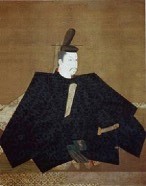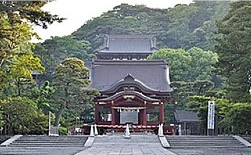By Jinzo Fujino *
The LES Japan has scheduled a day-trip to Kamakura as a post-conference tour of the 2019 LES International Conference in Yokohama. (See http://www.lesi.yokohama/tour/). Kamakura is an ancient city filled with old temples and shrines. You might be interested in joining the tour to enjoy the scenery and atmosphere of the city. This article introduces parts of the history of Kamakura to help you decide your itinerary for the tour.
The First Samurai Government
Ancient Japan was a nation ruled by the nobles. In the 12th century, armed individuals arose to challenge local lords all over the nation. Those individuals gradually formed the class of Samurai, or warriors. At that juncture, local lords were the foundation of aristocracy. The aristocratic government in Kyoto was eager to crush the riots.
Minamoto Yoritomo (Lord Yori) was born in 1148 as the first son of a high-ranked Samurai family. His father led a riot against the establishment but was killed during the battle. Lord Yori and his younger brother, Minamoto Yoshitsune (Tsune), were punished because of their father’s treason against the authority. Lord Yori was sent far away to Izu which was an uncivilized local district in the central part of Honshu, the main island. Tsune was also sent to a small temple located deep in the mountain of Kyoto. He read books and worked hard to be a good Samurai.
Lord Yori grew up there as a leader of the Samurai and became known among neighboring districts. His fame grew bigger and bigger through battles and struggles with local lords. He finally had a chance to begin a feud with Heike, the most powerful family in Kyoto and western part of Honshu. For Lord Yori, Heike was the enemy and he wanted to destroy them in revenge for his father’s death.
Tsune joined the battles with Heike and his performance was outstandingly remarkable. Many books wrote about his legendary performance during the conflicts. Despite his outstanding contribution, however, Tsune was not recognized for his bravery. Lord Yori envied Tsune and was concerned about his possible treason in the future. Knowing his brother’s envy, Tsune fled the districts under Lord Yori’s control. He sought a protection from the Fujiwara clan in Hiraizumi, 400 kilometers north of Kamakura. The founder of the Fujiwara clan warmly accepted him and instructed his sons and men to protect him.
After the conquest of Heike, Lord Yori’s next target was the Fujiwara clan that had been enjoying independence in the north for over a century. Financially backed by the abundant production of gold in his districts, the Fujiwara clan constructed many temples and shrines. Some of them were comparable to those in Kyoto. One of them was the Golden Hall (Kon Jiki Do). The Golden Hall, after repeated repairs and reconstructions, remains in great condition even today.
Lord Yori demanded that the Lord of the Fujiwara clan send Tsune back to Kamakura. His demand was ignored initially but, in the end, the Fujiwara clan decided to remove Tsune from Hiraizumi. Against the will of the founder, the Fujiwara clan killed Tsune and sent his head back to Kamakura with a letter of surrender.
Lord Yori used the incident of Tsune’s killing as an excuse for the attack of Hiraizumi. He mobilized many large armies from the rest of the nation and led them to Hiraizumi. The Fujiwara clan were not able to resist. This meant the Fujiwara clan were no longer the ruling Lords.
In Hiraizumi, Lord Yori was very impressed with mature culture in town. Temples and shrines were very prominent and statues and ornaments were colorfully decorated. Everything was new and exciting for Lord Yori. Upon returning to Kamakura, he started to work on the development of his town and built temples and shrines there. In 1192, the Kamakura Shogunate was inaugurated, which was the first central government of the Samurai class in Japan.
Culture Transfer
During his life, Lord Yori constructed three major buildings in Kamakura: Tsurugaoka Hachimangu Shrine, Sho-Chojuin Temple and Eifukuji Temple. The first one still remains (see photo 1) but the last two no longer exist. Since it was burned in 1405, Eifukuji Temple has not been reconstructed. A history book tells that it was a two-storied big hall copying its counterpart in Hiraizumi. Recent scientific research revealed that the base stones and cornerstones buried at the site of Eifukuji Temple had the same dimensions in length and depth as those of the counterpart in Hiraizumi. In addition to the building, its pond in the front yard was an exact copy of the pond of famous Motsuji Temple in Hiraizumi. Even now, the area in which Eifukuji Temple was buit is called Nikaido, which was named after the genuine hall in Hiraizumi.
The government established by Lord Yori did not last long, however. Political power gradually shifted to the hands of the Hojyo clan from which Lord Yori’s wife came. The Hojyo clan encouraged industrial development and expanded trade with China. Increased foreign trade resulted in the flow into the area of foreign commodities, Zen Buddhism and other things.
Zen Buddhism was in a form of mental discipline and became popular among the ordinary people. As Zen Buddhism became popular, the construction of Zen temples spread all over Kamakura. There are five well-known Zen temples in Kamakura: Kenchoji Temple, Enkakuji Temple, Jufukuji Temple, Jyochiji Temple and Jyomyoji Temple. They are classed as highly important temples, and called Kamakura Gozan (temples in the five mountains), which were officially accredited and supported by the government. The Kamakura Gozan are often compared to their counterparts in Kyoto (Kyoto Gozan).
Tips for Prayers
In Kamakura and elsewhere, it is suggested you follow the etiquette of the temples and shrines. Here are some tips for visitors:
1) Go to worship in a quiet and respectful manner. Shrines and temples are regarded as sacred places where the god and Buddha are enshrined. They are not mere sightseeing spots. Before you enter the precincts of the building, you should have a little bow. Then you may go in to worship.
2) Rules are there to protect valuable cultural assets. You should follow the rules which shrines and temples have established. Example: “Keep Out” and “No Tripods.”
3) Kamakura has an 800-year history as the ancient capital of the Samurai. Consider the history when you are in front of the shrines and temples. You may learn something new when you think of the history of the area.
*Editor/Office of Fujino IP Management
 |
| Lord Yori, the Commander-in-chief (1148-1199) (source: Wikipedia) |
 |
| Tsurugaoka Hachimangu Shrine, one of the three major buildings in Kamakura that Lord Yori constructed. (Source: Wikipedia) |
 |
| Enkakuji Temple, one of the five well known Zen temples in Kamakura. (Source: Wikipedia) |
